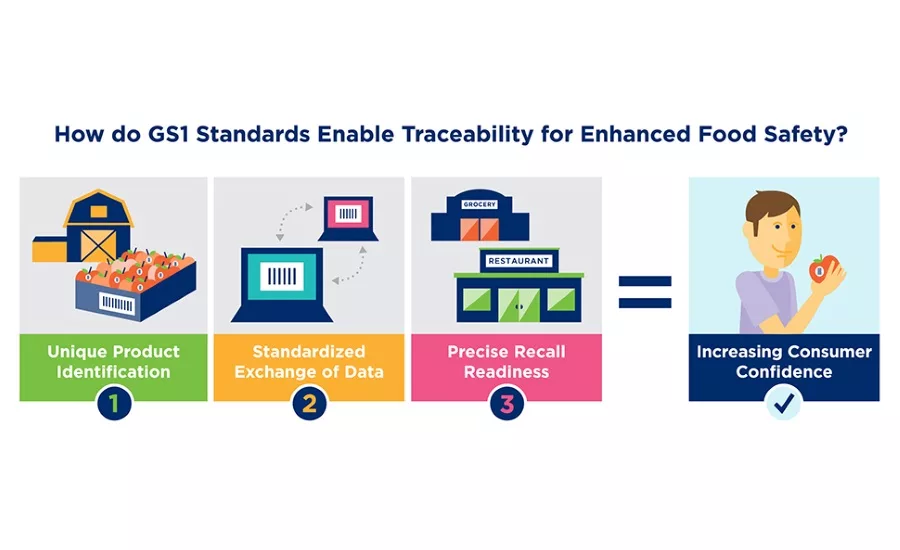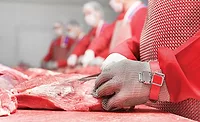Tracing our steps: How to build an effective traceability program


When the New Era of Smarter Food Safety plan was announced by the Food and Drug Administration in April, a strong emphasis was placed on the “modernization” aspect of the Food Safety Modernization Act (FSMA). The message was loud and clear—every food supply chain participant needs to work together “to create a more digital, traceable, and safer system.”
For many, traceability has already been a priority to avoid repeating costly food recalls, dating back to the notorious spinach recall of 2006. Thanks to widespread industry collaboration since then, more than half of the produce industry has implemented traceability processes utilizing GS1 Standards. These standards are more than just the barcode we see in the checkout line—global data standards provide consistency and interoperability that allows trading partners to “see” products as they move through the supply chain.
There are many different standards applied to different items and at different stages in the supply chain to enable this “visibility.” The following provides a hypothetical journey of a fully traceable tomato, along with an overview of the standards each supply chain partner uses to achieve supply chain visibility—a core component of end-to-end traceability.
Suppliers, processors and manufacturers
When it comes to implementing standards for improved traceability, remember three key words: identify, capture, and share. At the primary producer level, assigning unique identifiers called Global Trade Item Numbers (GTINs) to the food being harvested is the first step to making it visible in the supply chain. All other supply chain partners will rely on this information to trace a product in the event of a recall.
GTINs can be recognized in all trading partner systems, even across geographic boundaries. Similarly, a Global Location Number (GLN) is the globally unique identification number for supply chain partner locations such as a farm or field, a packing house, manufacturing plant, a wholesaler facility, a distributor’s loading dock, a store or a restaurant location. They help a company record each stop a product has made in the supply chain. Used together with dynamic event data, (such as the product’s creation, shipment, receipt and sale), these components are critical to tracking a product’s life cycle and are what really makes up supply chain visibility.
Let’s say a farm in New Jersey grows tomatoes and supplies them to a supermarket in upstate New York. The company packs and labels cases of their product with GTINs and production data (batch number, lot number, serial number, product dates, etc.). The case label contains this information in a human readable format and it is encoded into a GS1-128 barcode—a specialized barcode that clearly conveys this recall-pertinent product information in one place. The cases of tomatoes are then loaded onto a pallet and identified with a unique Serial Shipping Container Code (SSCC), which is used to identify the logistic units.
Looking for quick answers on food safety topics?
Try Ask FSM, our new smart AI search tool.
Ask FSM →
Another scenario could be, the tomato leaves the farm and arrives at a food processing plant in preparation to become ketchup. Since the product has been transformed, the manufacturer creates a new GTIN and applies this and the new batch/lot information to the GS1-128 barcode label. During this stage, most CPG manufacturers utilize the Global Data Synchronization Network (GDSN) to upload product data. Through the GDSN, all trading partners can access the most up-to-date product information in real time. Additionally, standardized transactional data is shared with downstream trading partners, which can come in the form of an EDI-Purchase Order (PO), Advance Ship Notice (ASN), Bill of Lading (BOL), or an invoice.
In this early stage of a product’s journey, it’s easy to see how the use of paper-based record keeping and proprietary numbering systems can hinder effective recall processes. Widespread efforts are underway to educate suppliers about the benefits of standards-based systems. They can support safe food handling processes and they bring significant cost savings to the entire operation. By reducing manual processes, suppliers can improve order accuracy, reduce delivery errors, and improve cash flow.
Distributors/Wholesalers and distribution centers
Next, the ketchup reaches the distributor where it is prepared to be shipped to the regional supermarket. Distributors use GTINs, GLNs, and SSCCs in their electronic data exchange for receipt verification, product put away, product pick, and shipment creation. They also use the information encoded on the case label for inventory rotation, order management, and quality control processes, which may intercept potentially contaminated product during a recall.
At this stop in the supply chain, product data is accessible to distributors and wholesalers in the GDSN and further information may be published if the product has been transformed in some way. The standards-based systems ultimately help distributors expedite product handling procedures, which can lead to more optimized truck capacity and better order accuracy overall. At this middle supply chain stop, distributors capture data about the product that can help all partners better manage inventory availability, and ultimately enhance the ability to provide end-consumers with fresher, higher quality products.
Point of consumption (retailer or foodservice operator)
The ketchup has made its way to the dock door of the upstate New York supermarket. The product’s barcodes are scanned, capturing the key identification data so the retailer knows what the product is and where it has come from, as well as information relevant during a recall such as batch, lot, and expiration date. This unique identification also helps with shelf stocking and recording sales.
Retailers also synchronize product data in the GDSN, which leads to increased accuracy for their e-commerce offering, and contributes to food safety through access to extended product details like nutrient and allergen information for consumers. Additionally, the store uses GTINs, SSCCs, and GLNs in other electronic data processes such as to confirm POs or ASNs, and also to check for any auto alerts of recalled products. Using the information that has been captured and shared throughout the supply chain, the retailer confirms that the ketchup is safe for consumption and stocks it on a center aisle.
The key takeaway from this hypothetical journey from source to store is that standards are critical to the modernization of the supply chain. A major digital transformation in the food supply chain is on the horizon. Now is the time to collaborate to drive more widespread food traceability forward to prepare for continued innovation.








